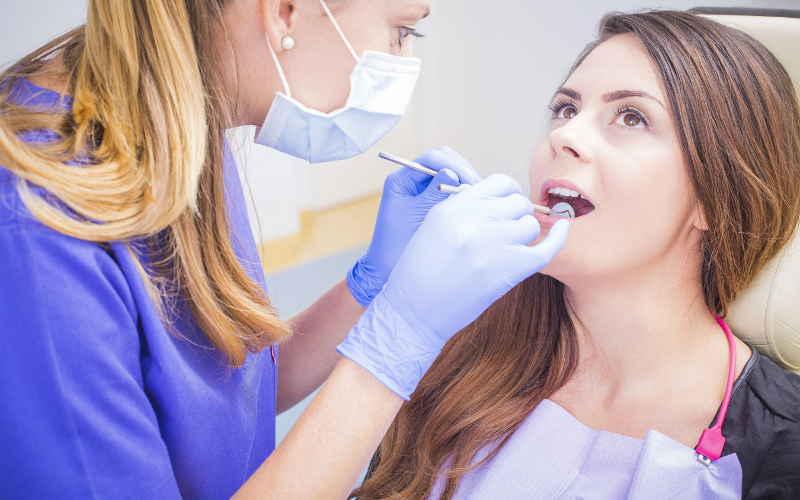Dental emergencies can strike at the most inconvenient times, and when they do, panic can easily set in. From sudden tooth pain to a knocked-out tooth, knowing how to respond and when to seek emergency dentistry can make a huge difference in preserving your oral health and avoiding unnecessary complications.
Today’s blog is all about giving you the tools to stay calm and take immediate action when faced with a dental emergency.
Common Dental Emergencies
Emergency dentistry varies in severity, but some of the most common issues include:
- Toothache
- Chipped or Broken Tooth
- Knocked-Out Tooth
- Lost Filling or Crown
- Abscess
- Soft Tissue Injuries
Each of these scenarios requires a different approach to treatment, and knowing what to do before reaching a dentist can save your tooth or alleviate pain.
Quick Fixes for Dental Emergencies
1. Toothache: Relieve The Pain
A toothache can result from various causes, including decay, infection, or injury. The pain can range from mild discomfort to unbearable throbbing.
Quick Fixes:
- Rinse your mouth with warm salt water to reduce inflammation.
- Brush your teeth to get rid of any food particles that are stuck.
- Take over-the-counter pain relievers, such as ibuprofen, to manage the pain.
- Apply a cold compress to your cheek if swelling is present.
What Not To Do?
Avoid placing aspirin directly on the tooth or gums, as it can burn the tissue.
2. Chipped or Broken Tooth: Prevent The Damage
Chipping or breaking a tooth can happen suddenly from an injury, biting into something hard, or tooth decay. Immediate care is essential to prevent further damage or infection.
Emergency dentistry can provide swift intervention, helping to repair the tooth, relieve pain, and protect it from further complications, ensuring the best possible outcome.
Quick Fixes:
- Rinse your mouth with warm water to clean the area.
- If there’s bleeding, apply a piece of gauze for 10 minutes to stop it.
- Use a cold compress to reduce swelling.
- Save any pieces of the tooth and bring them to the dentist.
Temporary Solutions:
If you can’t see the dentist immediately, cover the broken part of the tooth with dental cement (available at pharmacies) to prevent irritation.
3. Knocked-Out Tooth: Act Fast!
A knocked-out tooth can be a dental emergency that requires immediate action. If handled correctly, there’s a chance the tooth can be reinserted and saved.
Quick Fixes:
- Pick up the tooth by the crown (the top part), avoiding the root.
- Gently rinse it with water, be careful not to scrape or remove any pieces of tissue.
- Try to place the tooth back into its socket, holding it in place by gently biting it down.
- If reinsertion isn’t possible, keep the tooth in a cup of milk or a tooth preservation product (available at pharmacies).
What Not To Do?
Avoid using tap water to store the tooth, as it can damage the root. Time is of the essence; try to see a dentist within 30 minutes.
4. Lost Filling or Crown: Temporary Solutions
A lost filling or crown can leave your tooth exposed, causing discomfort and sensitivity.
Quick Fixes:
- Apply dental cement or sugarless gum to cover the exposed tooth and protect it temporarily.
- Avoid chewing on that side until you can see the dentist.
Emergency Tip:
If the crown is intact, try to slip it back over the tooth after cleaning it and applying dental cement.
5. Abscess: Manage Infection
An abscess is a serious infection that can form at the base of a tooth or in the gums, causing severe pain and swelling. It can spread to other bodily areas if left untreated.
Quick Fixes:
- Rinse your mouth with a saltwater solution several times a day to draw out the pus and reduce pain.
- Apply a cold compress to reduce swelling.
What To Do?
Seek emergency dental care because an abscess has to be treated by a professional dentist. Antibiotics may be necessary to treat the infection.
6. Soft Tissue Injuries: Stop The Bleeding
Injuries to the tongue, cheeks, or gums can bleed excessively and cause significant pain.
Quick Fixes:
- Rinse your mouth with salt water to clean the area.
- Apply pressure to the bleeding area with a clean gauze or cloth.
- Use a cold compress on the outside of the mouth to reduce swelling.
If the bleeding doesn’t stop after 15 minutes, seek emergency care immediately.
When To Seek Emergency Dentistry?

While some dental emergencies can be temporarily managed at home, there are certain situations where immediate dental or medical attention is critical:
- Uncontrollable bleeding
- Severe pain that isn’t relieved by over-the-counter medication
- Swelling in the face or jaw
- Signs of infection, such as fever, foul taste, or pus
Always call your dentist as soon as possible, even if you’re unsure whether the situation is an emergency. It’s better to address an issue early than risk complications later on.
Prevention Tips: How To Avoid Dental Emergencies?
Preventing dental crises in the first place is the best approach for handling them. Here are some proactive tips:
- Regular Dental Visits: Keep up with routine cleanings and checkups to catch potential problems early.
- Wear a Mouthguard: If you play sports or engage in activities where injury is likely, wearing a mouthguard can protect your teeth from damage.
- Watch Your Diet: Avoid biting down on hard foods, ice, or non-food items that can cause teeth to crack or chip.
- Maintain Good Oral Hygiene: Brushing, flossing, and using mouthwash daily can help keep decay and infection at bay.
Stay Calm and Be Prepared
Dental emergencies can be stressful, but knowing how to respond quickly and effectively can save your teeth and alleviate pain. Whether it’s managing a toothache or handling a knocked-out tooth, having the right knowledge and access to emergency dentistry can make all the difference.
To reduce risk, keep a dental emergency kit at home and schedule regular checkups. By being proactive and prepared, you can prevent a dental emergency from ruining your day.


